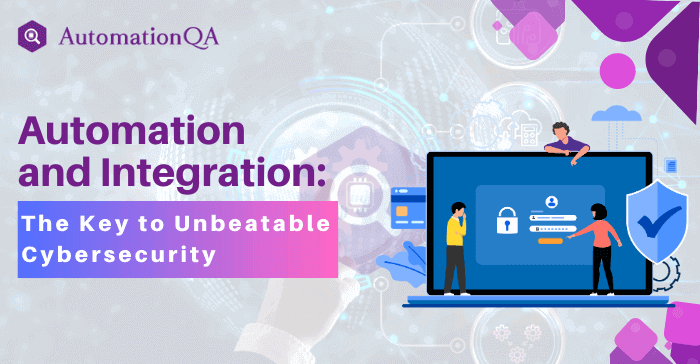
In the ever-evolving cybersecurity landscape, where threats lurk in the shadows and breaches loom as constant dangers, the need for innovative solutions has never been more pressing. Welcome to a world where algorithms work tirelessly and systems seamlessly communicate, empowering organizations to stay one step ahead in the battle against malicious actors.
This blog delves into the world of automation and integration, witnessing their magical fortification of the cyber defense landscape.
Introduction to Automation in Cybersecurity
Automation in information security refers to the application of technology to secure procedures and make them more efficient. It entails using intelligent tools and systems that can carry out various tasks on their own, including threat detection, incident response, and vulnerability management. By automating repetitive and time-consuming activities, organizations can free up valuable resources and enable their security teams to focus on more critical aspects of adequate security in technology and information systems.
The Advantages of Automation
Enhanced Threat Detection
More than manual detection techniques are required due to the volume and complexity of cyber threats that are constantly growing. By leveraging automation, businesses can harness the power of advanced algorithms and machine learning to identify potential threats in real time. Automated systems may quickly raise warnings, identify trends in massive amounts of data, and analyze the data to reduce the risk of undiscovered breaches.
Rapid Incident Response
Time is critical to reducing the impact; stopping more damage is quick action. Automation enables organizations to implement pre-defined incident response workflows that can be triggered automatically. By orchestrating the response process, businesses can reduce human error, ensure consistency in actions taken, and expedite incident containment and recovery.
Proactive Vulnerability Management
Any effective cybersecurity strategy critically incorporates vulnerability management. Automated vulnerability assessment tools can continuously scan systems, applications, and networks for potential weaknesses. By identifying vulnerabilities proactively, organizations can prioritize remediation efforts and apply patches or updates promptly, significantly reducing the window of opportunity for attackers.
Efficient Resource Utilization
Automation allows businesses to optimize resource allocation within their Cyberwarfare teams. Organizations may devote their experienced employees to more strategic work like threat research and security architecture design by automating regular operations like log analysis and system monitoring. This enables more efficient use of human resources, ultimately leading to a better overall cybersecurity posture.
Integration: Unifying Cybersecurity Efforts
Integration refers to the seamless connection and coordination of security solutions, tools, and processes within an organization’s cybersecurity infrastructure. By integrating disparate systems, QA automation companies can create a unified defense mechanism that enables comprehensive threat visibility, efficient incident response, and holistic security management.
Centralized Threat Intelligence
The integration allows organizations to consolidate threat intelligence from various sources into a central repository. Businesses can comprehensively view the threat landscape by aggregating data from security tools, threat feeds, and industry reports. This centralized intelligence can then be analyzed to identify emerging patterns, anticipate potential attacks, and devise proactive security measures.
Coordinated Incident Response
Effective coordination and communication among different security solutions and teams are paramount in the face of a cybersecurity tools incident. Integrated systems enable seamless sharing of information and automated workflows, ensuring that incident response efforts are synchronized. Organizations can respond swiftly and decisively by eliminating silos and fostering collaboration, minimizing the impact of security breaches.
Holistic Security Management
The integration enables organizations to manage their entire Cyberbullying infrastructure from a central console. Businesses can gain a unified view of their security posture by integrating security solutions such as firewalls, intrusion detection systems, and endpoint protection platforms. This holistic approach allows for centralized policy management, efficient monitoring, and quickly identifying potential vulnerabilities or misconfigurations.
The Power of Automation and Integration Combined
While integration and automation have much to offer, their full potential comes from working together. By integrating automated security tools and processes into a unified Cyberbullying infrastructure, organizations can achieve unparalleled protection against various threats.
When automation cybersecurity and integration are harnessed, their synergy creates an unbeatable information security framework. By leveraging automation and integration, organizations can stay one step ahead of cybercriminals, fortifying their defenses and safeguarding critical data.
Real-time Threat Hunting
Automation can empower security teams with advanced threat-hunting capabilities. By integrating threat intelligence feeds, automated data analysis, and machine learning algorithms, businesses can proactively search for indicators of compromise and identify potential threats before they materialize.
Streamlined Incident Response
Integrating automated incident response workflows with a centralized management system enables a streamlined and efficient response to security incidents. When an alert is triggered, automated actions such as isolating affected systems, blocking malicious IP addresses, or launching forensic investigations can be initiated. This coordinated response minimizes response time, reduces human error, and maximizes the chances of successful containment.
Continuous Security Monitoring
Cybersecurity automation and integration facilitate continuous security monitoring across the entire infrastructure. Automated systems can monitor real-time network traffic, log files, and user activities, flagging suspicious behavior or anomalies. Organizations can detect and respond to threats at any stage of the attack lifecycle. This is possible by combining continuous monitoring with integrated threat intelligence.
Adaptive Defense Mechanisms
Automation and integration allow organizations to build adaptive defense mechanisms that dynamically respond to evolving threats. Businesses can develop adaptive learning systems from past incidents by integrating security solutions with machine learning. This adaptive approach enhances resilience and ensures that security measures remain effective even against previously unseen threats.
Wrap Up
In a world under cyber threat, the power of cybersecurity automation and integration stands as a beacon of hope. Stay on the leading edge like top automation consulting firms that streamline security processes, enhance threat detection, facilitate proactive vulnerability management, and optimize resource utilization.
